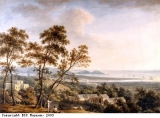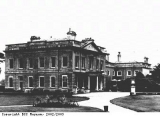Estates within 5 miles of Bristol
Stoke Bishop, in north Bristol, is today the home of the Trinity Theological College. The building was enlarged in 1666 by Sir Robert Cann, though it is probably of medieval origin (dated between 1000 and 1453). Cann was an important Bristol merchant who had been the city’s Mayor in 1662. He was related to the Yeamans family (of Redland Court) on his mother’s side, and owned properties in Jamaica. Cann campaigned in 1663 for a law to be introduced against the practice of kidnapping white children to work on Caribbean plantations. This was just one method used to find workers for the plantations. Yet Cann himself was fined £1000 (about £50,000 today) in 1685 by the harsh Judge Jeffreys for corruptly taking criminals to work on Bristol-owned plantations there.
Blaise Castle at Henbury, north Bristol, was a folly – a building with no use, in this case built to enhance the view. It was built by Thomas Farr who bought the Blaise estate in 1762. Farr had extensive investments in the slave trade. It is said that he built the £3,000 folly (about £150,000 today) so that he could view his ships sailing back up the River Avon to Bristol from it. The Blaise estate was previously part of Henbury Manor which had been owned a century before by Sir Samuel Astry. It is known that an African slave lived in the Great House there as the servant of Sir Samuel’s son-in-law, the seventh Earl of Suffolk, until his early death in 1719. The black servant was named after an ancient Roman general of African origin, Scipio Africanus. The nickname might have meant to make fun of the servant’s lowly position as a slave in comparison to the high-ranking Roman general of the same name. Scipio Africanus’s tombstone still stands in the nearby Henbury Churchyard, though his actual burial there is not confirmed in the church records.
Kings Weston manor, in south-west Bristol, was bought by Robert Southwell in 1679 from Sir Humphrey Hooks. Hooks is described as having important connections in both Bristol and the Caribbean island of Barbados. Robert Southwell was a high-ranking government official with political interests in both Ireland and the Caribbean. His son Edward I (1670-1730), who also held high government posts, began to restore Kings Weston House employing the famous Vanbrugh as architect. Improvements to the house and gardens was continued by his son Edward II. He was M.P. for Bristol in 1739 until 1754, and actively promoted the city’s involvements in the slave trade. This view of the Bristol Channel shows the house (rebuilt by Vanbrugh) on the left, with the stable block in the centre of the picture. A family portrait of 1737 shows Edward and his family with an unnamed black servant. In 1822, the family sold the estate to Philip Miles who had made a huge fortune from the Caribbean sugar plantations.




